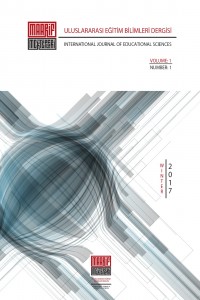Review
Yol Gösterici İki Öğretim Kuramı: Merill’ın Öğe Belirleme Kuramı ve Reigeluth’un Öğretimi Ayrıntılama Kuramı
Abstract
Bu makalenin temel amacı 1980’li yılların başında M. D. Merrill tarafından geliştirilen Öğe Belirleme Kuramı (ÖBK) ile yine 1980’li yılların başında C. M. Reigeluth tarafından geliştirilen Öğretimi Ayrıntılama Kuramını (ÖAK) genel hatlarıyla tanıtmaktır. Öğretim biliminin çalışma alanı, öğretimi daha etkili, daha verimli ve daha ilgi çekici yapabilmek amacıyla öğretim yöntemlerinin anlaşılması ve geliştirilmesini kapsar (Reigeluth, 1983, s.338). Öğretim bilimcilerinin görevleri ise; öğretim kuramlarını temel alarak öğretim sürecinde kullanılabilecek, önceden belirlenmiş hedeflere ulaşılmasını sağlayan öğretim yöntemlerini geliştirmektir (English, 1992, s. 2). Öğretim tasarımı alanı, öğretim sürecinde makro ve mikro düzeyde bilgi sağlar. Bu düzeyler iki şekilde farklılık göstermektedir. Bunlar; içerik kapsamı ve ilgili bellek türüdür (Van Patten, Chao ve Reigeluth, 1986, s.437). (1) Mikro düzey (Merrill’in Öğe Belirleme Kuramı); içeriğin tek bir parçasının öğretimi için taktiklerle ilgiliyken, (2) makro düzey (Regileuth’un Öğretimi Ayrıntılama Kuramı); öğretim daha büyük miktardaki içeriğinin seçimi, yapılandırılması, sıralanması, sentezlenmesi ve özetlenmesiyle ilgilidir. Başka bir anlatımla Mikro stratejiler; bellek kazanımı üzerine odaklanır. Öğrencinin bireysel olarak belleğinde etkin bir biçimde bilgi toplayabilmesi için tasarlanmıştır. Makro stratejiler belleğin düzenlenmesine odaklanmışlardır. Amaçları tüm bilgi ve beceri dağarcığında değişiklikler yaratmak ve etkilemektir (Van Patten, Chao & Reigeluth, 1986, s.438)
References
- Hoffmann, S. (1997). Elaboration theory and hypermedia: ıs tehere a link? Educational Technology 3,1, 57-64. Karataş & Coşkun. M. (1999). Eğitime giriş dersindeki bazı kavramların kazandırılmasında öğeleri belirleme kuramı ile geleneksel öğretimin akademik başarı ve kalıcılığa etkisi. Yayınlanmamış Doktora Tezi. Çukurova Üniversitesi, Sosyal Bilimler Enstitüsü, Adana. Karataş & Coşkun. M. (2017). Öğretim İlke ve Yöntemleri. (Ed. Doğanay, A. Ed.) 11. Baskı, s. 89-140 (3. Bölüm), Ankara: Pegem Akademi. Kutlu, M.O. (1999). Öğretimi ayrıntılama kuramına dayalı matematik öğretimi ve bilgisayar destekli sunumun başarıya ve kalıcılığa etkisi. Yayınlanmamış Doktora Tezi. Çukurova Üniversitesi, Sosyal Bilimler Enstitüsü, Adana. Kutlu, M.O. (2002). Öğretimi ayrıntılama kuramına dayalı matematik öğretimi ve bilgisayar destekli sunumun başarı ve kalıcılığa etkisi. Sakarya Üniversitesi Eğitim Fakültesi Dergisi, Özel Sayı:2, Uluslar arası Eğitim Teknolojileri Sempozyum ve Fuarı Bildirileri 4,305-322. Mayer, R.E. (1981). An evaluation of the elaboration model of instruction from the perspective of assimilation theory. Journal of Instructional Development 5(1),23-25. Merrill,M.D. Kelety,J.C. & Wilson, M.(1981). Elaboration theory and coknitive psychology. Instructional Science, 10 (3), 217-235. Merrill,M.D. (1983). Instructional Design Theories and Models. NJ: Hillsdale, Lawrence Erlbaum Associates, Publishers. Reigeluth, C.M.(1983). Instructional Design Theories and Models. NJ: Hillsdale, Lawrence Erlbaum Associates, Publishers. Reigeluth, C.M., & Darwazeh,A.(1982). The elaboration theory’s procedure for designing instruction-a conceptual approach. Journal of Instructional Development 5(3), 22-32. Reigeluth, C.M. (1987). Instructional Theory in Action. NJ: Hillsdale, Lawrence Erlbaum Associates, Publishers. Tekin, H. (2003). Eğitimde Ölçme ve Değerlendirm. Ankara: Yargı Basım-Yayım. Van Patten,J; Caho, C. & Reigeluth,C.M.(1986). A review of startegies for sequencing and synthesizizng instruction, Review of Educational Research 56 (4), 437-471.
Two Prescriptive Instructional Theories: Merrill’s Component Display Theory and Reigeluth’s Elaboration Theory
Abstract
The main objective of this article is to introduce in general terms the Component Display Theory in the 1980s by M.D.Merrill and the Elaboration Theory of Instruction developed by C.M. Reigeluth in the 1980s. The study field of instructional science is concerned with understanding and improving methods of instruction so as to makes hem more effective, more efficient, and more appealing (Reigeluth, 1983, p.338). The task of instructional scientist is to build a knowledge base in instructional theory- a body of knowledge that prescribes instructional methods for the practitioner to use to bring about desired outcomes (English, 1992, p.2). The knowledge base of instructional design provides insight at the macro and micro level. This level differs in two ways: the scope of content and the type of memory concerned (Van Patten, Chao & Reigeluth, 1986, p.437). (1) Micro level (Merrill’s Component Display Theory) deals with tactics for teaching a single piece of the content while the macro level (Reigeluth’s Elaboration Theory of Instruction) deals with selecting, structuring, sequencing, synthesizing and summarizing la focus on memory acquisition. They are designed to efficiently "fill the individual registers" of the student with information. Macro strategies focus on the organization of memory. Their goal is to create, or effect changes in, the structure of (an) entire skill and knowledge repertoire (Van Patten, Chao & Reigeluth, 1986, p.438).
References
- Hoffmann, S. (1997). Elaboration theory and hypermedia: ıs tehere a link? Educational Technology 3,1, 57-64. Karataş & Coşkun. M. (1999). Eğitime giriş dersindeki bazı kavramların kazandırılmasında öğeleri belirleme kuramı ile geleneksel öğretimin akademik başarı ve kalıcılığa etkisi. Yayınlanmamış Doktora Tezi. Çukurova Üniversitesi, Sosyal Bilimler Enstitüsü, Adana. Karataş & Coşkun. M. (2017). Öğretim İlke ve Yöntemleri. (Ed. Doğanay, A. Ed.) 11. Baskı, s. 89-140 (3. Bölüm), Ankara: Pegem Akademi. Kutlu, M.O. (1999). Öğretimi ayrıntılama kuramına dayalı matematik öğretimi ve bilgisayar destekli sunumun başarıya ve kalıcılığa etkisi. Yayınlanmamış Doktora Tezi. Çukurova Üniversitesi, Sosyal Bilimler Enstitüsü, Adana. Kutlu, M.O. (2002). Öğretimi ayrıntılama kuramına dayalı matematik öğretimi ve bilgisayar destekli sunumun başarı ve kalıcılığa etkisi. Sakarya Üniversitesi Eğitim Fakültesi Dergisi, Özel Sayı:2, Uluslar arası Eğitim Teknolojileri Sempozyum ve Fuarı Bildirileri 4,305-322. Mayer, R.E. (1981). An evaluation of the elaboration model of instruction from the perspective of assimilation theory. Journal of Instructional Development 5(1),23-25. Merrill,M.D. Kelety,J.C. & Wilson, M.(1981). Elaboration theory and coknitive psychology. Instructional Science, 10 (3), 217-235. Merrill,M.D. (1983). Instructional Design Theories and Models. NJ: Hillsdale, Lawrence Erlbaum Associates, Publishers. Reigeluth, C.M.(1983). Instructional Design Theories and Models. NJ: Hillsdale, Lawrence Erlbaum Associates, Publishers. Reigeluth, C.M., & Darwazeh,A.(1982). The elaboration theory’s procedure for designing instruction-a conceptual approach. Journal of Instructional Development 5(3), 22-32. Reigeluth, C.M. (1987). Instructional Theory in Action. NJ: Hillsdale, Lawrence Erlbaum Associates, Publishers. Tekin, H. (2003). Eğitimde Ölçme ve Değerlendirm. Ankara: Yargı Basım-Yayım. Van Patten,J; Caho, C. & Reigeluth,C.M.(1986). A review of startegies for sequencing and synthesizizng instruction, Review of Educational Research 56 (4), 437-471.
There are 1 citations in total.
Details
| Journal Section | Articles |
|---|---|
| Authors | |
| Publication Date | December 31, 2017 |
| Published in Issue | Year 2017 Volume: 1 Issue: 1 |

